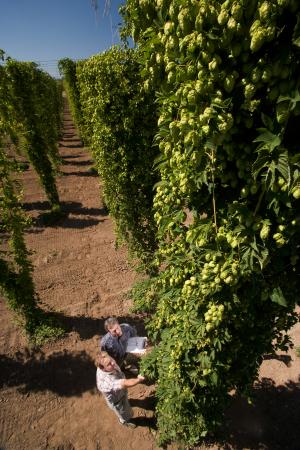Compound from hops aids cognitive function in young animals

The research was just published in Behavioral Brain Research by scientists from the Linus Pauling Institute and College of Veterinary Medicine at Oregon State University. It’s another step toward understanding, and ultimately reducing the degradation of memory that happens with age in many mammalian species, including humans.
Flavonoids are compounds found in plants that often give them their color. The study of them – whether in blueberries, dark chocolate or red wine – has increased in recent years due to their apparent nutritional benefits, on issues ranging from cancer to inflammation or cardiovascular disease. Several have also been shown to be important in cognition.
Xanthohumol has been of particular interest because of possible value in treating metabolic syndrome, a condition associated with obesity, high blood pressure and other concerns, including age-related deficits in memory. The compound has been used successfully to lower body weight and blood sugar in a rat model of obesity.
The new research studied use of xanthohumol in high dosages, far beyond what could be obtained just by diet. At least in young animals, it appeared to enhance their ability to adapt to changes in the environment. This cognitive flexibility was tested with a special type of maze designed for that purpose.
“Our goal was to determine whether xanthohumol could affect a process we call palmitoylation, which is a normal biological process but in older animals may become harmful,” said Daniel Zamzow, a former OSU doctoral student and now a lecturer at the University of Wisconsin/Rock County.
“Xanthohumol can speed the metabolism, reduce fatty acids in the liver and, at least with young mice, appeared to improve their cognitive flexibility, or higher level thinking,” Zamzow said. “Unfortunately it did not reduce palmitoylation in older mice, or improve their learning or cognitive performance, at least in the amounts of the compound we gave them.”
Kathy Magnusson, a professor in the OSU Department of Biomedical Sciences, principal investigator with the Linus Pauling Institute and corresponding author on this study, said that xanthohumol continues to be of significant interest for its biological properties, as are many other flavonoids.
“This flavonoid and others may have a function in the optimal ability to form memories,” Magnusson said. “Part of what this study seems to be suggesting is that it’s important to begin early in life to gain the full benefits of healthy nutrition.”
It’s also important to note, Magnusson said, that the levels of xanthohumol used in this study were only possible with supplements. As a fairly rare micronutrient, the only normal dietary source of it would be through the hops used in making beer, and “a human would have to drink 2000 liters of beer a day to reach the xanthohumol levels we used in this research.”
In this and other research, Magnusson’s research has primarily focused on two subunits of the NMDA receptor, called GluN1 and GluN2B. Their decline with age appears to be related to the decreased ability to form and quickly recall memories.
In humans, many adults start to experience deficits in memory around the age of 50, and some aspects of cognition begin to decline around age 40, the researchers noted in their report.
This research was supported by the National Institutes of Health.
About the Linus Pauling Institute: The Linus Pauling Institute at OSU is a world leader in the study of micronutrients and their role in promoting optimum health or preventing and treating disease. Major areas of research include heart disease, cancer, aging and neurodegenerative disease.
Media Contact
All latest news from the category: Agricultural and Forestry Science
Newest articles

New method for designing artificial proteins
Protein design aims to create customized antibodies for therapies, biosensors for diagnostics, or enzymes for chemical reactions. An international research team has now developed a method for designing large new…

Data collector on the seafloor
New measuring node was placed off Boknis Eck today. One of the oldest marine time series stations in the world is located in Eckernförde Bay, just under two kilometres off…

NASA: Mystery of life’s handedness deepens
The mystery of why life uses molecules with specific orientations has deepened with a NASA-funded discovery that RNA — a key molecule thought to have potentially held the instructions for…



